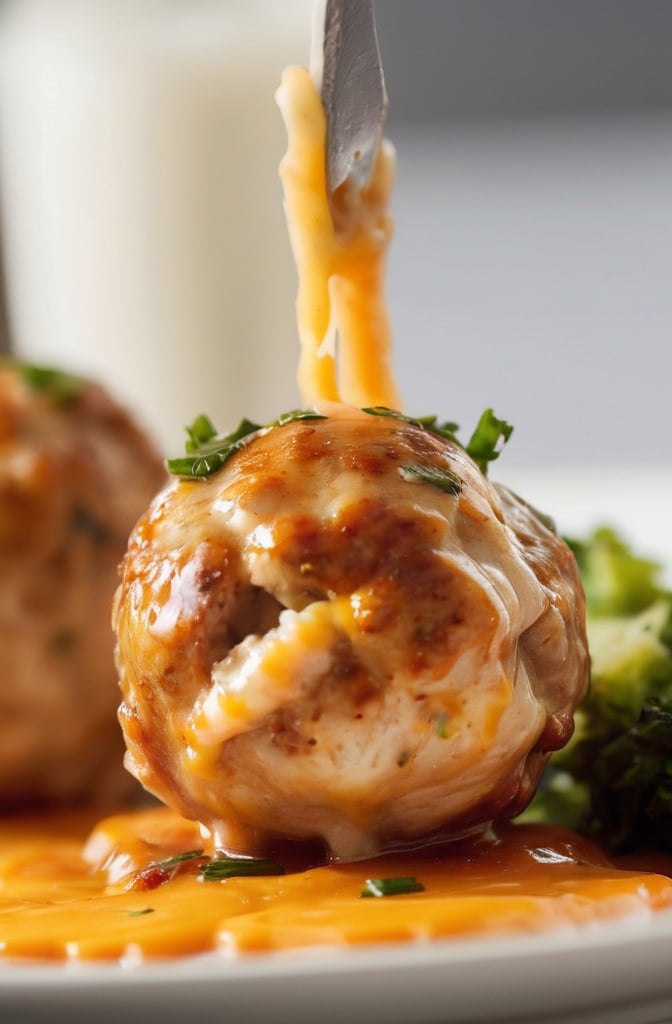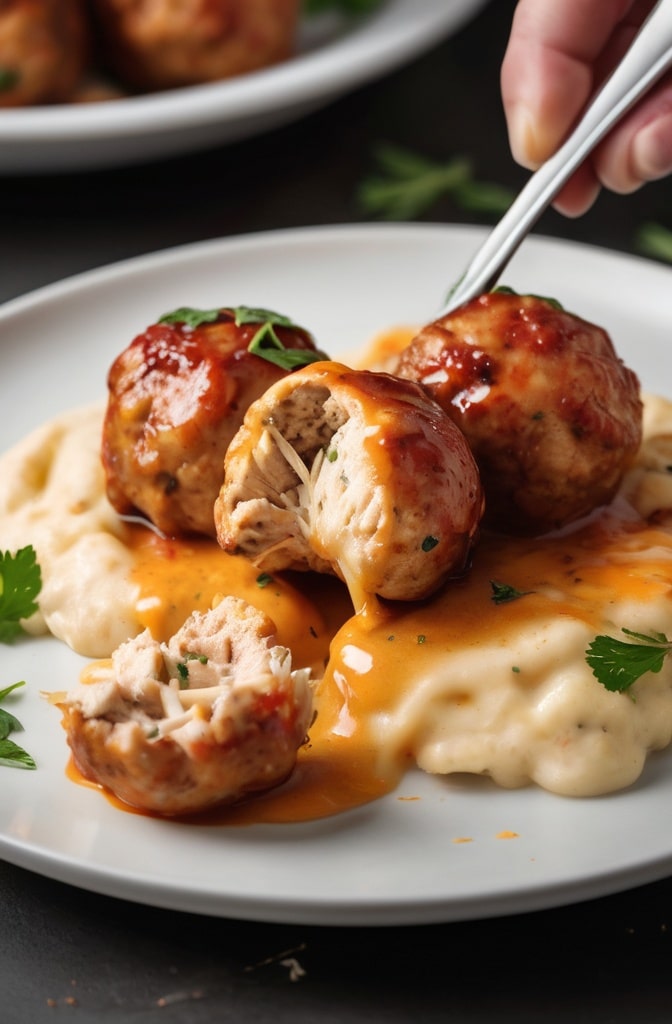The lightbulb moment hit me during a late-night fridge raid. There I stood, red-handed with half a basket of those addictive Red Lobster biscuits from dinner, wondering what could possibly elevate them beyond their buttery, garlicky perfection. Then it struck me what if those iconic flavors weren’t just alongside my protein, but fully integrated into it? Could the beloved Cheddar Bay profile transform the humble chicken meatball into something extraordinary?
These Cheddar Bay Chicken Meatballs represent the best kind of culinary fusion taking the distinct, craveable flavor profile of those famous biscuits and reimagining it in protein form. The result? Tender, juicy chicken meatballs infused with sharp cheddar, garlic, herbs, and a hint of cayenne that delivers all the nostalgic flavors of those legendary biscuits while standing firmly as their own culinary achievement. This isn’t just comfort food it’s comfort food that’s had a glow-up.
Ingredients & Substitutions

For the Meatballs:
- 2 pounds ground chicken (preferably thigh meat)
- 1 cup sharp cheddar cheese, freshly grated
- 1/2 cup panko breadcrumbs
- 1/4 cup buttermilk
- 2 large eggs, lightly beaten
- 4 cloves garlic, minced
- 2 tablespoons fresh parsley, finely chopped
- 1 tablespoon dried chives (or 2 tablespoons fresh)
- 2 teaspoons baking powder
- 1 1/2 teaspoons kosher salt
- 1 teaspoon garlic powder
- 1 teaspoon onion powder
- 1/2 teaspoon cayenne pepper
- 1/4 teaspoon Old Bay seasoning
- 3 tablespoons unsalted butter, melted
- 2 tablespoons olive oil (for cooking)
For the Cheddar Bay Butter Sauce:
- 6 tablespoons unsalted butter
- 3 cloves garlic, minced
- 1/2 teaspoon Old Bay seasoning
- 1 tablespoon fresh parsley, finely chopped
- 1/4 teaspoon sea salt flakes
Let’s talk substitutions, because I know not everyone has the same pantry situation going on. Ground turkey works beautifully here if chicken isn’t your thing, though I’d recomend the dark meat varieties for proper moisture. If you’re dairy-sensitive, swap the cheddar for a plant-based alternative, but make sure it’s one that actually melts—those waxy ones will ruin the experience.
For the breadcrumbs situation, gluten-free panko is widely available now and performs nearly identically. No buttermilk in the fridge? No problem. Mix 1/4 cup regular milk with a teaspoon of lemon juice or white vinegar, let it sit for 5 minutes, and voilà—emergency buttermilk.
The cheese quality matters tremendously here—pre-shredded varieties contain anti-caking agents that inhibit proper melting. Take the extra two minutes to grate your own cheddar; the sharper the better for that distinctive Cheddar Bay punch. Those magical little cheese pockets create steam during cooking, which helps keep our meatballs gloriously moist.
Old Bay seasoning is non-negotiable if you want the true experience. That distinctive blend of celery salt, paprika, black and red pepper creates the signature backbone of the Cheddar Bay profile. In an absolute emergency, you could mix 1/8 teaspoon celery salt with 1/8 teaspoon paprika and a pinch of cayenne, but it’s worth seeking out the real deal.
Step-by-Step Instructions
Preparing the Meatball Mixture:
- In a large bowl, combine ground chicken, grated cheddar, panko breadcrumbs, buttermilk, beaten eggs, minced garlic, parsley, chives, baking powder, salt, garlic powder, onion powder, cayenne, and Old Bay seasoning. The baking powder might seem odd here, but trust me—it creates tiny air pockets that result in a lighter texture, mimicking the fluffy interior of those famous biscuits.
- Add the melted butter to the mixture and gently fold everything together using your hands or a fork. The most common mistake here is overworking the mixture which results in tough, dense meatballs. Mix just until combined—you should still see distinct specks of herbs and cheese.
- Cover the bowl and refrigerate for at least 30 minutes, or up to 4 hours. This resting period is crucial as it allows the breadcrumbs to fully hydrate and the flavors to properly meld. Skipping this step is like serving a wine without letting it breathe—technically possible, but you’re cheating yourself of peak flavor.
I cannot emphasize enough how critical a light touch is when mixing meatballs. Treat the mixture like it’s a tempermental soufflé—with respect and minimal handling. Your hands are warm, and that heat can start melting the cheese and butter prematurely. If your hands run particularly warm, periodically rinse them under cold water, dry them thoroughly, and continue mixing.
Forming and Cooking the Meatballs:
- After resting, remove the mixture from the refrigerator. With lightly oiled hands (another pro tip to prevent sticking), gently form meatballs approximately 1 1/2 inches in diameter, about the size of a golf ball. You should get around 24-28 meatballs. Place them on a parchment-lined baking sheet as you work.
- Heat 2 tablespoons olive oil in a large, heavy-bottomed skillet over medium heat. Working in batches to avoid crowding (which creates steam instead of browning), cook the meatballs for about 2-3 minutes per side, turning gently with a silicone spatula or wooden spoon to maintain their shape. The goal is a beautiful golden crust that seals in moisture.
- Transfer browned meatballs to a clean baking sheet and finish cooking in a preheated 375°F oven for 8-10 minutes, or until the internal temperature reaches 165°F. If your first batch seems to be browning too quickly, reduce the heat slightly for subsequent batches. Remember, we’re going for golden, not charred.
For a variation that delivers an even more pronounced Cheddar Bay experience, try creating a cheese pocket. Form each meatball around a small cube of sharp cheddar, ensuring the cheese is completely enclosed. When baked, these create the most delightful melty center that will have your guests wondering how you achieved such sorcery.
If you’re calorie-conscious but still want that delicious pan-sear flavor, try this hybrid method: Brown the meatballs for just 1 minute per side to develop that crucial flavor crust, then transfer to a 375°F oven and bake for 15 minutes. You’ll use significantly less oil but still get that beautiful outer texture.
Preparing the Cheddar Bay Butter Sauce:
- While the meatballs finish in the oven, prepare the sauce. In a small saucepan, melt butter over medium-low heat. Once melted, add minced garlic and cook for about 30 seconds until fragrant but not browned. Garlic burns in the blink of an eye, turning bitter and ruining your sauce—keep that heat moderate and your attention undivided.
- Remove from heat and stir in Old Bay seasoning, chopped parsley, and sea salt flakes. The residual heat will bloom the spices and release their essential oils without risking that bitter burnt garlic flavor.
- When meatballs are fully cooked, transfer them to a large bowl, drizzle with the warm butter sauce, and gently toss to coat. The sauce should cling to each meatball, creating a glistening, aromatic glaze that echoes those brushed biscuit tops.
For a tangier variation, add a teaspoon of lemon zest and a tablespoon of fresh lemon juice to the butter sauce. The citrus brightness cuts through the richness beautifully and adds a sophisticated dimension to the flavor profile.
Cooking Techniques & Science
Let’s geek out for a moment on why these meatballs work so brillinatly. The science behind their tenderness comes down to three critical factors: fat content, binding agents, and cooking technique.
First, the fat matrix: Ground chicken thigh contains significantly more fat than breast meat, creating natural moisture reserves that prevent drying. The melted butter and cheese contribute additional fat that coats the protein strands, limiting their ability to tighten and expel moisture during cooking. It’s essentially creating little force fields around the protein molecules.
The inclusion of baking powder might seem strange in a meatball recipe, but it serves a brilliant purpose. When activated by the moisture and heat, it releases carbon dioxide bubbles that create microscopic air pockets throughout the meatball. These pockets not only lighten the texture but also interrupt the protein network, preventing the meat from becoming too dense and tough. It’s the same principle that makes those famous biscuits so fluffy, translated into meatball form.
Browning the meatballs before finishing them in the oven utilizes the Maillard reaction—that complex dance between amino acids and reducing sugars that creates hundreds of new flavor compounds. This reaction occurs optimally between 280°F and 330°F. When you sear the exterior of the meatball, you’re creating a flavor-packed crust while also forming a moisture barrier that helps trap juices inside during the gentler oven finish.
The resting period in the refrigerator performs several crucial functions. Beyond allowing flavors to develop, the cold temperature firms the fats in the mixture, making the meatballs easier to shape. It also gives the salt time to dissolve and begin breaking down some of the protein strands, creating a better texture. Think of it as a mini-cure that improves both flavor and mouthfeel.
A digital instant-read thermometer is non-negotiable here. The visual cues for doneness in chicken can be misleading, particularly when other ingredients are incorporated. By confirming an internal temperature of 165°F, you ensure food safety without risking overcooking. The difference between a perfectly juicy meatball and a disappointing dry one can be just 5-7 degrees of internal temperature.
Serving & Pairing Suggestions
These Cheddar Bay Chicken Meatballs shine as both appetizers and entrees, depending on how you present them. For cocktail party perfection, serve them with decorative toothpicks and the remaining butter sauce in a small ramekin for dipping. Watch how quickly they disappear.
For a more substantial presentation, create a meatball-centric pasta dish. Nest them atop buttered egg noodles with a light garlic cream sauce, garnished with additional shredded cheddar and fresh herbs. The pasta becomes a canvas for soaking up that incredible butter sauce.
For a low-carb option that doesn’t sacrifice the experience, serve these meatballs over cauliflower mash with roasted garlic. The creamy base provides the perfect counterpoint to the savory meatballs, and the nutritional profile remains balanced.
Wine pairings should emphasize complementing that distinctive cheddar-garlic profile without overwhelming it. A buttery California Chardonnay makes a natural companion, its vanilla notes harmonizing with the rich meatballs. If you prefer red, reach for something with moderate tannins a Merlot or Pinot Noir would be lovely. Beer enthusiasts should consider an amber ale whose caramel notes will echo the browned exterior of the meatballs.
For a truly Instagram-worthy presentation, serve the meatballs in a cast iron skillet garnished with fresh herb sprigs, lemon wedges, and additional sea salt flakes. The rustic presentation against the black pan makes those golden-brown spheres pop visually. Eat first with your eyes, as they say.
Make-Ahead and Storage Options
The beauty of these meatballs extends to their make-ahead potential, making them perfect for entertaining. The raw meatball mixture can be prepared up to 24 hours in advance and kept covered in the refrigerator. This not only saves time before guests arrive but actually improves the flavor as the ingredients have more time to become acquainted.
You can also form the raw meatballs and freeze them on a baking sheet before transferring to a freezer-safe container. They’ll keep beautifully for up to three months. When you’re ready to cook, thaw them overnight in the refrigerator for best results.
Fully cooked meatballs can be refrigerated for up to 3 days. Reheat them gently in a 300°F oven with a splash of chicken broth in the bottom of the pan to maintain moisture. Microwave reheating works in a pinch, but the texture suffers significantly—the crust softens and the interior can become rubbery.
The butter sauce can be made up to 5 days ahead and stored in an airtight container in the refrigerator. Simply rewarm it gently before serving. If it separates during storage, a quick whisk while reheating will bring it back together.
Nutritional Benefits and Dietary Adaptations

Beyond being utterly delicious, these meatballs offer a solid nutritional profile when enjoyed in moderation. Chicken provides lean protein, while the cheese adds calcium and additional protein. The herbs and garlic aren’t just flavor enhancers—they bring antioxidants and anti-inflammatory compounds to the party.
For those watching carbohydrate intake, the minimal breadcrumb quantity keeps the carb count reasonable. You can further reduce it by substituting almond flour for the panko, though you’ll need to reduce the quantity by about 25% since almond flour doesn’t absorb moisture the same way.
Gluten-free diners can enjoy these with the simple switch to gluten-free panko or even crushed rice Chex cereal, which provides similar texture. For dairy restrictions, plant-based butter and cheese substitutes work well, though as mentioned earlier, choose meltable varieties for best results.
Reducing sodium is simple omit the added salt and use a low-sodium version of Old Bay seasoning. The cheese will still provide enough sodium for flavor enhancement without overloading the dish.
Conclusion
These Cheddar Bay Chicken Meatballs represent what I love most about modern cooking—the fearless fusion of beloved flavors reimagined in surprising forms. They honor the nostalgic profile of those famous biscuits while standing proudly as their own culinary achievement.
The secret to their success lies in understanding the science behind meatball perfection: the right meat-to-fat ratio, gentle handling, proper binding agents, and that crucial two-step cooking method. Master these elements, and you’ll create meatballs that are both technically excellent and emotionally satisfying.
Remember, cooking is both science and soul. The measurements matter, but so does the memory of what those Cheddar Bay flavors mean to you. Did they accompany celebrations or provide comfort on ordinary days? That context flavors your cooking as much as any herb or spice.
Whether served as sophisticated appetizers or hearty main courses, these meatballs bring something special to the table—a familiar flavor in an unexpected form, executed with technical precision but served with heart. And isn’t that the very definition of great cooking?
FAQs
Can I make these Cheddar Bay Chicken Meatballs ahead of time for a party?
Absolutely! These meatballs are entertaining superstars. Prepare and shape them up to 24 hours in advance, keeping them covered in the refrigerator. You can even brown them earlier in the day, refrigerate, and then finish them in the oven just before serving. For maximum convenience, fully cook them ahead of time and gently reheat at 300°F with a splash of chicken broth to maintain moisture. The butter sauce can be prepared up to 5 days ahead and gently rewarmed just before tossing with the meatballs.
My meatballs always fall apart when cooking. What am I doing wrong?
This common frustration usually stems from one of three issues. First, check your binding ratio—these meatballs need both eggs and breadcrumbs in the specified proportions to hold together properly. Second, the refrigeration step isn’t just for flavor development—it firms up the mixture, making it easier to shape and maintain structure during cooking. Finally, handle the meatballs minimally during cooking; excessive flipping disrupts the protein bonds that are trying to set. Use a gentle touch with a silicone spatula rather than tongs, which can pierce and break the meatballs.
Can I bake these meatballs instead of pan-searing them first?
Yes, though you’ll sacrifice some of that delicious browned exterior that contributes significantly to the flavor profile. If choosing the baking-only method, arrange the meatballs on a parchment-lined baking sheet, spray or brush them lightly with oil, and bake at 425°F for about 15-18 minutes, or until they reach an internal temperature of 165°F. For a compromise that delivers better results, try broiling them for the last 2-3 minutes to achieve some browning.
How can I make these meatballs dairy-free while maintaining that Cheddar Bay flavor?
The dairy components provide both flavor and moisture, so thoughtful substitution is key. Replace the cheddar cheese with a high-quality dairy-free melting cheese—cashew-based varieties tend to perform best. Substitute the buttermilk with unsweetened, plain coconut yogurt thinned with a tablespoon of water. For the butter in both the meatballs and sauce, use a plant-based butter that’s designed for cooking (not spreading). To compensate for the lost flavor dimension that dairy provides, consider increasing the Old Bay seasoning by 25% and adding a half teaspoon of nutritional yeast to the mixture.
What’s the best way to serve these as a main course rather than an appetizer?
To transform these meatballs into a satisfying main course, think about creating a complete plate with complementary flavors and textures. They pair beautifully with creamy polenta or mashed potatoes, which echo the comfort food quality while providing a canvas for that delicious butter sauce. A bright, acidic side like lemon-dressed arugula or a vinegar-based slaw provides necessary contrast to the richness. For a restaurant-quality presentation, place a pool of polenta or mashed potato on each plate, arrange 4-5 meatballs on top, drizzle with additional butter sauce, and garnish with microgreens or herb sprigs and a light dusting of smoked paprika.

